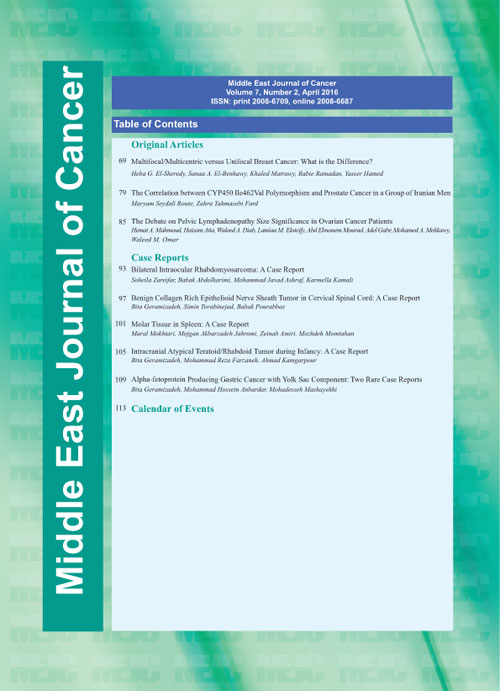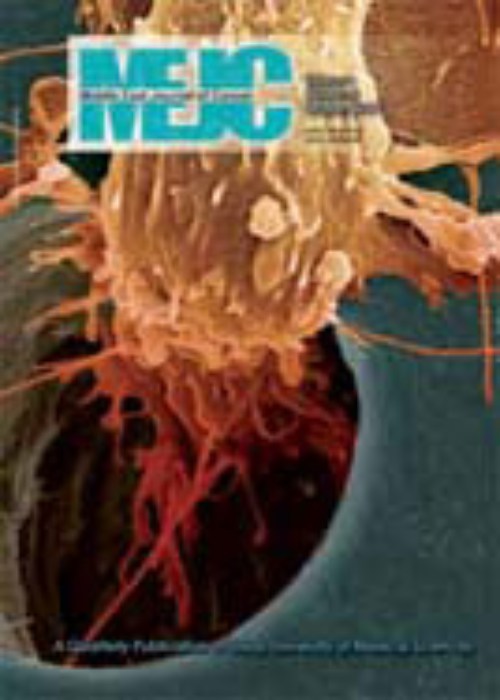فهرست مطالب

Middle East Journal of Cancer
Volume:7 Issue: 2, Apr 2016
- تاریخ انتشار: 1395/02/02
- تعداد عناوین: 9
-
-
Pages 69-78BackgroundAlthough multifocal and multicentric breast cancers are a common entity, their clinical behavior is not well characterized. With the widespread use of mammographic screening and improved sensitivity of imaging modalities, the detection of multifocal and multicentric breast cancers is likely to continuously increase. Many studies have consistently shown a correlation between multifocality and multicentricity and the rate and extent of lymph node metastases. There is little clinical data on the impact of multifocal and multicentric breast cancers on survival outcomes. This study investigates the difference between multifocal and multicentric breast cancers and unifocal breast cancer regarding pathologic and clinical parameters. We have evaluated the impact of multifocal and multicentric breast cancers on disease-free and overall survival of breast cancer patients.MethodsIn this retrospective study, we reviewed the records of female patients newly diagnosed with breast cancer who presented to the department of Cancer Management and Research, Medical Research Institute, Alexandria University in the time period from January 2009 till December 2009. Patients with pathologically proven stages I-III invasive breast cancer were included in this study. Patients clinical and pathological characteristics were compared between the two studied groups. The disease free and overall survivals were analyzed using the KaplanMeier method.ResultsMultifocal and multicentric breast cancers were associated with a number of known adverse prognostic factors such as higher clinical stage, larger tumor size and lymphovascular invasion. There was a significant correlation between multifocal and multicentric breast cancers and increased rate of axillary lymph node metastasis and higher N stage. Multifocal and multicentric breast cancer patients had shorter median 5-year disease free survival and overall survival compared to unifocal breast cancer patients. In multivariate analysis, after adjustment of other factors, only clinical stage and multifocality/multicentricity were independent predictors of poor disease free and overall survival.ConclusionThere is an association between multifocal and multicentric breast cancers and known adverse prognostic factors such as increased incidence of regional lymph node metastases. This association may suggest that multifocal and multicentric breast cancers have an aggressive biology and more propensity for metastasis. Whether multifocal and multicentric breast cancer is an adverse prognostic factor in breast cancer remains controversial.Keywords: Multifocal, Multicentric, Breast cancer, Prognostic factors, Survival outcomes
-
Pages 79-84BackgroundCytochrome P450 plays an important role in pharmaceutical metabolism, steroidal hormones and procarcinogens. CYP1A1 is an enzyme, which is very active in the formation of reactive mediators or injurious agents for DNA. The aim of this study is to evaluate the prevalence rate of genetic polymorphism RS 1048943 gene CYP1A1 in men diagnosed with prostate cancer compared to a control group of healthy men.MethodsThis case-control study analysed blood samples from 79 patients with prostate cancer as well as 79 healthy men. Genomic DNA was extracted by the salting out method. After selecting the suitable primers from the papers, the samples were amplified for the considered segment and genotypes of the participants were determined by PCR-RFLP.ResultsIndividuals with prostate cancer had the following genotypes: AA (31.64%), GG (59.49%) and AG/GA (8.86%) compared to the control group that had genotypes AA (55.69%), GG (29.11%) and AG/GA (15.18%). According to the HardyWeinberg equilibrium, the frequency of allele A was 36.7% in the cancer group and 63.29% in the control group. The frequency of allele G was 63.92% in the cancer group and 36.70% in the control group. There were meaningful differences in the frequencies of homozygotes GG (PConclusionPolymorphism RS 1048943 in gene CYP1A1 is related to the risk of developing prostate cancer and it is likely one of the major factors in its occurrence.Keywords: Polymorphism RS 1048943, Cytochrome 1A1 (CYP1A1), Prostate cancer
-
Pages 85-91BackgroundThis study attempts to ascertain a reliable cutoff size to determine whether pelvic lymph nodes are metastatic or not in ovarian cancer patients.MethodsWe retrospectively reviewed 73 PET/CT scans of 52 female patients with ovarian carcinoma who underwent surgery followed by chemotherapy. The findings of contrast enhanced MDCT were interpreted by two experienced radiologists unaware of the PET/CT findings. At least two experienced nuclear medicine physicians unaware of the contrast enhanced-MDCT findings examined the PET scans in order to localize, characterize and compare these scans to co-registered PET/CT images. A comparative study was done. Lymph node sizes were recorded in short axis diameter with a significant cut off estimated at 7.5 mm. Metabolic activities of different lymph node groups were assessed and the semi-quantitative SUV was calculated. The level of SUV significance was 2.5. Significant metastatic lymph nodes were judged by the assessment of integrated PET/CT results.ResultsOf the 73 scans, 47 showed significant lymph node metastases, with the following sensitivities: 75% (external iliac), 77.8% (internal iliac), and 75% (inguinal). The specificities were 84% (external iliac), 86% (internal iliac), and 54% (inguinal) with a P-value of 0.000 for the external an internal iliac groups and 0.079 for the inguinal group.ConclusionTo improve detection of malignant pelvic lymph nodes, the size threshold should be decreased to 7.5 mm.Keywords: Malignant, Pelvic lymph nodes, CT, PET, CT
-
Pages 93-95Here we report the case of a 1.5-year-old Iraqi boy who was referred for chemotherapy after left eye enucleation. The patient had a history of left eye leukocoria since 2 months of age. According to history, physical examination and paraclinical work up, he was first diagnosed as a case of retinoblastoma by an ophthalmologist. However, the pathology report favored embryonal rhabdomyosarcoma. In conclusion, a patient with leukocoria should be evaluated carefully for other underlying malignancies.Keywords: Orbital tumor, Pediatric, Rhabdomyosarcoma
-
Pages 97-100Tumors that originate from the nerve sheath comprise diverse groups -perineuroma, neurofibroma and schwannoma. The epithelioid variant of these tumors is uncommon and mostly seen in malignant counterparts. Although this type of morphology is well recognized in peripheral nerve sheath tumors, its presence in the central nerves is rarely reported. Very few cases of nerve sheath tumors have been reported with collagen-rich stroma. Here we report an extremely rare case of nerve sheath tumor with epithelioid morphology and collagen rich stroma. To the best of our knowledge this finding in the spinal cord has not been reported thus far.Keywords: Epithelioid collagen rich nerve sheath tumor, Cervical spinal cord
-
Pages 101-103An invasive mole is a rare form of gestational trophoblastic disease in which the molar tissue invades into the deep myometrium, cervical stroma, blood vessels or extrauterine sites. This report is of an invasive mole of spleen that has originated from an ectopic pregnancy, which was primarily though to be a choriocarcinoma.Keywords: Spleen, Invasive Mole, Hydatidiform mole
-
Pages 105-108Central nervous system atypical teratoid/rhabdoid tumor during infancy is a rare, highly aggressive tumor most commonly seen in the cerebellar area. Herein we describe the case of a 4-month-old baby who presented with convulsions. Pathologic examination of her cerebellar mass showed an atypical teratoid/rhabdoid tumor. The patient died 5 days after surgery despite complete excision of the mass and prior to chemoradiation. Histopathologic diagnosis of this tumor type should be considered in posterior fossa masses of children, particularly before the age of 2 years, because the treatment protocol and prognosis of this tumor completely differ from other tumors of this region such as medulloblastoma and primitive neuroectodermal tumors.Keywords: Atypical teratoid, rhabdoid tumor of infancy, Brain, Infant
-
Pages 109-111Alpha-fetoprotein producing gastric cancer accounts for less than 10% of the gastric adenocarcinomas. Different histologic subtypes may exist, the least common of which is yolk sac morphology. To the best of our knowledge less than 10 cases have been reported with high alpha-fetoprotein and yolk sac components, either pure or mixed with ordinary adenocarcinoma of the stomach. During 10 years, from among more than 500 gastric adenocarcinoma cases that presented to the largest referral center in Southern Iran, two cases of gastric cancer with yolk sac components and high alphafetoprotein have been diagnosed, as presented in this case report.Keywords: Alfa, fetoprotein, Gastric cancer
-
Page 112


